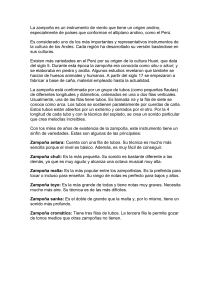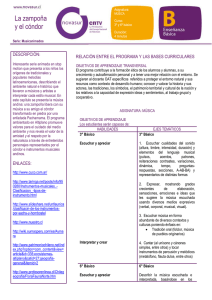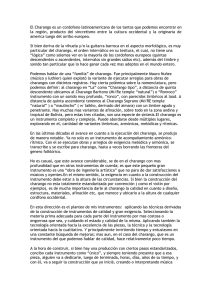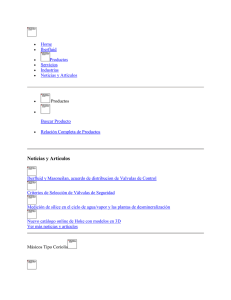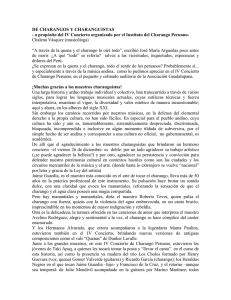Glossary Behind the Instruments
Anuncio
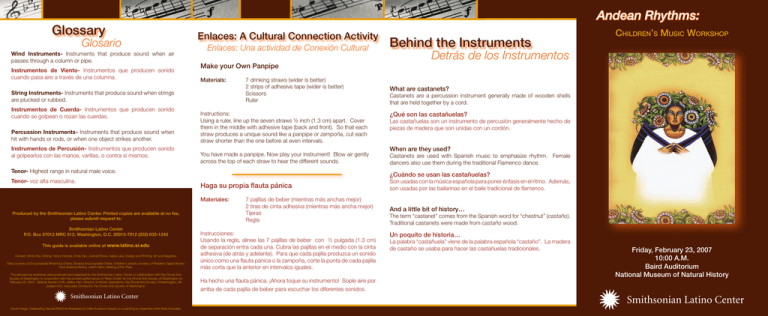
Glossary Glosario Wind Instruments- Instruments that produce sound when air passes through a column or pipe. Instrumentos de Viento- Instrumentos que producen sonido cuando pasa aire a través de una columna. Andean Rhythms: Enlaces: A Cultural Connection Activity Enlaces: Una actividad de Conexión Cultural Percussion Instruments- Instruments that produce sound when hit with hands or rods, or when one object strikes another. Instrumentos de Percusión- Instrumentos que producen sonido al golpearlos con las manos, varillas, o contra sí mismos. Materials: 7 drinking straws (wider is better) 2 strips of adhesive tape (wider is better) Scissors Ruler Instructions: Using a ruler, line up the seven straws ½ inch (1.3 cm) apart. Cover them in the middle with adhesive tape (back and front). So that each straw produces a unique sound like a panpipe or zampoña, cut each straw shorter than the one before at even intervals. You have made a panpipe. Now play your instrument! Blow air gently across the top of each straw to hear the different sounds. Tenor- Highest range in natural male voice. Tenor- voz alta masculina. Smithsonian Latino Center P.O. Box 37012 MRC 512, Washington, D.C. 20013-7012 (202) 633-1240 This guide is available online at www.latino.si.edu Content: Emily Key. Editing: Henry Estrada, Emily Key. Joanne Flores, Isabel Lara. Design and Printing: Art and Negative. Data courtesy of Encyclopedia Britannica Online, Encarta Encyclopedia Online. Children’s activity courtesy of Readers Digest Books: How Science Works, Judith Hann, Making a Pan-Pipe. The educational workshop was produced and organized by the Smithsonian Latino Center in collaboration with the Choral Arts Society of Washington in conjunction with the concert performance of “Misa Criolla” by the Choral Arts Society of Washington on February 25, 2007. Special thanks to Mr. Jeffery Hart, Director of Artistic Operations, the Choral Arts Society of Washington, Mr. Joseph Holt, Associate Conductor, the Choral Arts Society of Washington. Smithsonian Latino Center Cover Image: Celebrating Sacred Rhythms illustrated by Celia Anderson based on a painting by Argentine artist Nivia Gonzalez. What are castanets? Castanets are a percussion instrument generally made of wooden shells that are held together by a cord. ¿Qué son las castañuelas? Las castañuelas son un instrumento de percusión generalmente hecho de piezas de madera que son unidas con un cordón. When are they used? Castanets are used with Spanish music to emphasize rhythm. Female dancers also use them during the traditional Flamenco dance. ¿Cuándo se usan las castañuelas? Haga su propia flauta pánica Materiales: Produced by the Smithsonian Latino Center. Printed copies are available at no fee, please submit request to: Detrás de los Instrumentos Make your Own Panpipe String Instruments- Instruments that produce sound when strings are plucked or rubbed. Instrumentos de Cuerda- Instrumentos que producen sonido cuando se golpean o rozan las cuerdas. Behind the Instruments CHILDREN’S MUSIC WORKSHOP 7 pajillas de beber (mientras más anchas mejor) 2 tiras de cinta adhesiva (mientras más ancha mejor) Tijeras Regla Instrucciones: Usando la regla, alinee las 7 pajillas de beber con ½ pulgada (1.3 cm) de separación entra cada una. Cubra las pajillas en el medio con la cinta adhesiva (de atrás y adelante). Para que cada pajilla produzca un sonido único como una flauta pánica o la zampoña, corte la punta de cada pajilla más corta que la anterior en intervalos iguales. Ha hecho una flauta pánica. ¡Ahora toque su instrumento! Sople aire por arriba de cada pajilla de beber para escuchar los diferentes sonidos. Son usadas con la música española para poner énfasis en el ritmo. Además, son usadas por las bailarinas en el baile tradicional de flamenco. And a little bit of history… The term “castanet” comes from the Spanish word for “chestnut” (castaño). Traditional castanets were made from castaño wood. Un poquito de historia… La palabra “castañuela” viene de la palabra española “castaño”. La madera de castaño se usaba para hacer las castañuelas tradicionales. Friday, February 23, 2007 10:00 A.M. Baird Auditorium National Museum of Natural History Smithsonian Latino Center Overview Behind the Instruments The Andean Region and its Music: The Sounds of the Andes: The Andean region is made up of seven countries, including Venezuela, Colombia, Ecuador, Peru, Bolivia, Chile, and Argentina. At approximately 5500 miles, the Andes Mountains are the longest mountain chain in the world and one of the highest, second only to the Himalayas. Mount Aconcagua, Lake Titicaca, the Ring of Fire, and the Amazon River are just some of the natural wonders that are part of this region. Due to the vast area and diverse people, present-day music and traditions of the region are a blend of cultural and ethnic influences, which include Pre-Columbian, African, and Spanish colonial traditions. Wind and string instruments characterize highland Andean music. It mixes African, Spanish, and Indigenous rhythms that evoke an atmosphere of mountains and wide-open spaces that are emblematic of the region. The meeting of cultures occurs with the arrival of the Spanish, which results in the creation of instruments such as the charango. This instrument uses native materials and draws its inspiration from European and Spanish string instruments like the lute and the vihuela. Detrás de los Instrumentos What is a charango? A charango is a small guitar composed of five strings and a body of armadillo shell or wood. It forms part of the string family of instruments. ¿Qué es un charango? Un charango es un guitarrillo compuesto por cinco cuerdas y un cuerpo de concha de armadillo o madera. Forma parte de la familia de instrumentos de cuerdas. When is it used? A charango is used with traditional indigenous music of Northern Argentina. It usually accompanies a singer or the quena (a type of panpipe) player. ¿Cuándo se usa? La región Andina y su Música: Los Sonidos de los Andes: La región Andina es compuesta de siete países incluyendo a Venezuela, Colombia, Ecuador, Perú, Bolivia, Chile, y Argentina. Los Andes son la cadena de montañas más largas del mundo (aproximadamente 5500 millas) y una de las más altas, después de los Himalaya. El monte Aconcagua, el lago Titicaca, la Tierra del Fuego, y el Río Amazonas son sólo unas de las maravillas naturales que forman parte de esta región. Debido a la gran área y la diversidad de gente que se encuentra en esta región, la música y tradiciones de hoy en día son una mezcla de influencias culturales y étnicas, incluyendo a las tradiciones pre-colombinas, africanas, y del virreinato. La música de la tierra alta de los Andes se caracteriza por instrumentos de viento y de cuerda. La música mezcla los ritmos africanos, españoles, e indígenas, para crear una sensación de montañas y de campo abierto, cualidades que son emblemáticas de la región. Se puede ver la unión de las culturas con la llegada de los españoles que resulta en la creación de instrumentos como el charango. Este instrumento usa materiales nativos y obtiene su inspiración en los instrumentos de cuerda europeos y españoles como el laúd y la vihuela. El charango es usado con la música tradicional e indígena del norte de Argentina. Usualmente acompaña al cantante o al tocador de la quena (una flauta pánica). What is a zampoña? A zampoña is a panpipe and is a sister to the flute and the quena (another type of pan-pipe), all which form part of the wind instrument family. The zampoña can be made of bamboo and includes 23 pipes. Each pipe is shorter than the one it is next to and produces a unique sound. ¿Qué es una zampoña? Una zampoña es una flauta pánica y es de la familia de la flauta tradicional y la quena (otro tipo de flauta pánica). Todos estos instrumentos forman parte de la familia de instrumentos de viento. La zampoña puede ser hecha de bambú e incluye 23 tubos. Cada tubo es más corto que su vecino y produce un sonido diferente. When and where are they used? Zampoña’s can be found in most continents and are used in ceremonies, rituals, and traditional music. ¿Dónde y cuando son usadas? And a little bit of history… The charango is a descendant of the old European “guitarilla” and the Spanish vihuela. Un poquito de historia… El charango es un descendiente de la antigua “guitarrilla” europea y la vihuela española. Las zampoñas se pueden encontrar en casi todos los continentes y son usadas durante ceremonias, rituales, y en música tradicional. And a little bit of history… Zampoña’s are also known as siku or antara, depending on the region. The word zampoña comes from the Greek, siku is of Aymará origin, and antara is its Quechua name. The zampoña dates back to the Incan Empire. Un poquito de historia… Las zampoñas también son conocidas como sikus o antaras dependiendo de la región. La palabra zampoña viene del griego, mientras que siku es de origen aymará, y antara de origen quechua. La zampoña puede ser remontada al Imperio Inca.

